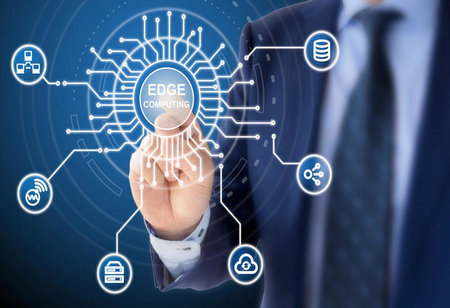What Is Edge Computing And How Is It Affecting Corporate Sector?
By Sthitaprajnya Panigrahi
 Still an uncharted domain, edge computing is slowly emerging as a massive technical trend to work beyond the limitations of cloud computing networks. As per a recent study, companies investing in edge computing are expected to achieve a growth rate of more than 20 percent by 2022. Already familiar with cloud computing and its applications, Organizations are still on a conduit to understanding the concepts of edge computing.
Still an uncharted domain, edge computing is slowly emerging as a massive technical trend to work beyond the limitations of cloud computing networks. As per a recent study, companies investing in edge computing are expected to achieve a growth rate of more than 20 percent by 2022. Already familiar with cloud computing and its applications, Organizations are still on a conduit to understanding the concepts of edge computing.
How Is It Different From Cloud Computing?
Unlike cloud computing in which the data is transferred to a centralized location where it is processed and then sent back to the requester, in edge computing data processing happens at the source of the data. Dealing with a huge amount of data using cloud computing can negatively impact some of the real-time applications as the time required for data processing will proportionally increase along with it. On the contrary, edge computing mitigates these limitations providing easy access to the data. But contradicting some of the notions, edge computing cannot replace cloud computing completely as the processed data needs to be stored for future references. However, both can be implemented by the enterprises while dealing with a huge amount of data for data traffic reduction and easy data processing.
Advantages of Edge Computing:
Some of the major advantages of edge computing include:
- Edge computing enhances the possibility of real-time data analysis, as it is processed and analyzed in the device itself.
- As the data is processed within the system instead of transferred to the specific cloud portal, it will ensure higher performance and minimal latency.
- An effective way to reduce network congestion or traffic by allowing the passage of minimum data, edge computing lessens the network load.
- Minimizes the operational and maintenance related costs, by eliminating the concept of the common data center.
- It also provides much-needed security to the enterprises as a centralized cloud computing architecture will be more vulnerable to attack and data loss.
Disadvantages of Edge Computing:
- Consisting of highly diversified networks, it possesses the risks of data tampering.
- A properly deployed edge computing will cease if it is not maintained and operated effectively.
- Like every other resource, it must be revised and regulated timely to ensure its proficiency.
- Server management and programmability are the toughest hurdles while dealing with edge computing.
As companies are more willing to take advantage of edge computing, to optimize their networks for better reliable services and customer satisfaction, it is bound to play a more vital role in the upcoming days. Still, at an infantry level, edge computing needs more advancement in the framework to come out as one of the strongest platforms of data processing. With many challenges to mitigate, it is on a continuous path of scaling new heights. Offering numerous advantages over traditional forms of data management and network architecture, it has become one of the most sought after latest technology trends.




